How to Install Custom Fonts
Custom fonts can make a presentation unique, dynamic, align with corporate branding and many other fantastic things. But if a custom font is not installed on the device being used to show the presentation, the presentation may fail visually.

If your presentation is using a custom font, here is an overview on how to get that font installed on all the main device types – if it is possible to install.
Windows Desktop OS
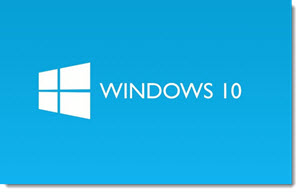
Installing a custom font is a simple process on Windows.
Option 1: Select Install
Confirm the font files are copied to the computer (not on a portable drive or network folder). Right-Click the font file and select > Install. Windows will do everything and the font is now available to all programs on that computer.
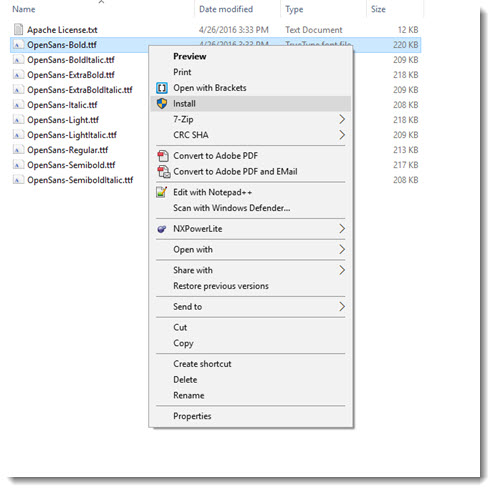
Option 2: Drop and Drag into Fonts Folder
Manually copy font files into the Windows Fonts folder. When a font file is copied into the Windows Font Folder it is automatically installed.
Windows 10: To see what fonts are installed, go to the Windows icon> Settings > type “Fonts” in the search bar on the top right. Your fonts folder should open, displaying currently installed fonts. Drag-and-drop, or copy/paste, font files to be installed.
Win XP, 7 and Win 8.1: To see what fonts are installed, go to Windows Start > Control Panel > Fonts, this will take you to a list of all fonts installed on your PC. Drag-and-drop, or copy/paste, font files to be installed.
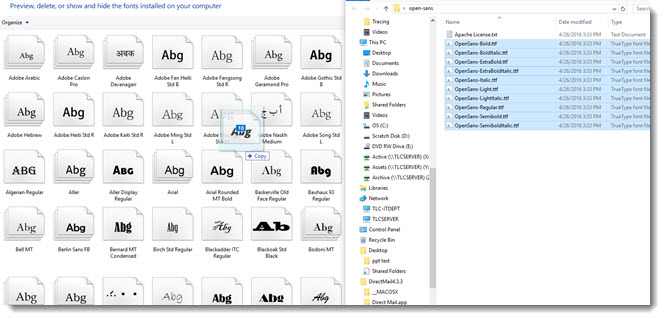
A few notes about PowerPoint using custom fonts on Windows:
- PowerPoint (all versions) can only recognize TrueType (TTF) and OpenType (OTF) formats.
- PowerPoint needs to be opened, or restarted, AFTER the custom font is installed. If a font is installed while PowerPoint is open, it will not show up in the font list until PowerPoint is restarted.
Mac OS
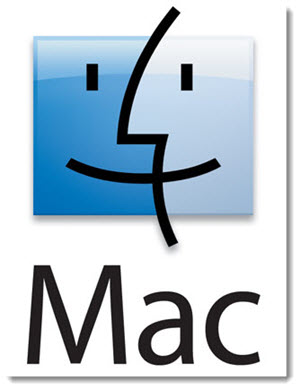
Option 1
- Double-click the font file to open a dialog fonts displaying the font. Click “Install Font” button.
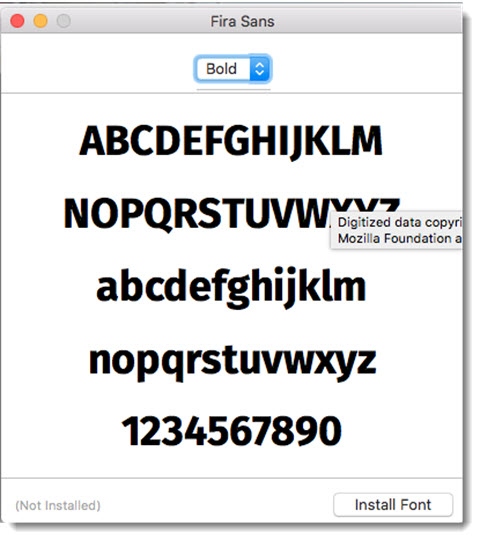
Option 2
- Launch Font Book, a Mac OS application. This displays all fonts on the computer. Choose Add Fonts from the file menu and select the font you want to install.
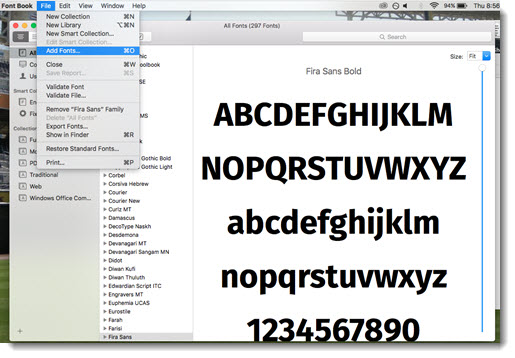
A few notes about PowerPoint and Keynote using custom fonts on the Mac OS:
- PowerPoint and Keynote can use TrueType (TTF), OpenType (OTF), and PostScript (PS) formats.
- The Mac OS fonts cannot be used on Windows computers.
- PowerPoint needs to be opened, or restarted, AFTER the custom font is installed. If a font is installed while PowerPoint is open, it will not show up in the font list until it is restarted.
- Keynote dynamically recognizes newly installed custom fonts and are immediately available without restarting the app
iOS on iPad and iPhone

- Custom fonts can be download and installed, but not all apps can use/see the custom fonts.
- iOS uses TrueType (.TTF) and OpenType (.OTF) fonts.
- PowerPoint for IOS installs with selection of preset “safe” fonts that are available on all platforms.
- Microsoft has recently implemented a new dynamic font library that will download and install additional fonts if they are used in a presentation. The presentation opens and if the font is not currently installed on the iOS device, a substitute font is automatically used. Then in the background, if the device has online access, the additional fonts are downloaded, installed and the presentation is dynamically updated to use the fonts. So a slide with a font not currently installed (but a Microsoft font) may initially display with a font substitution, and while you are looking at it, change to the correct font that has been downloaded and added to PowerPoint’s font library.
- The dynamically installed fonts on iOS are only “Office compatible” fonts, or fonts from Microsoft. So true custom fonts, non-Microsoft fonts, are not available.
- Keynote application uses the preset fonts installed with IOS. Third party apps can be used to install other fonts onto the IOS device, which are then available to Keynote.
Android and Chromebooks
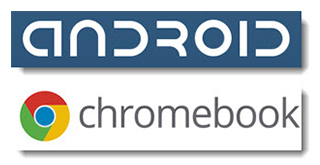
- Android uses TrueType (.TTF) and OpenType (.OTF) font formats.
- The Android OS is similar to IOS, it has preset fonts installed. There are several addon apps that allow additional fonts to be installed.
- One confusing thing when talking about fonts for Android is they have a font named “Android” and another named “Droid”, but other fonts are available. what happens when other fonts are used in a presentation – I will send details when I get them so you can add to post)
- PowerPoint for Android installs with selection of preset “safe” fonts that are available on all platforms.
- Microsoft has recently implemented a new dynamic font library that will download and install additional fonts if they are used in a presentation. The presentation opens and if the font is not currently installed on the Android device, a substitute font is automatically used. Then in the background, if the device has online access, the additional fonts are downloaded, installed and the presentation is dynamically updated to use the fonts. So a slide with a font not currently installed (but a Microsoft font) may initially display with a font substitution, and while you are looking at it, change to using the correct font that has been downloaded and added to PowerPoints font library.
Windows Mobile Phone
- Windows 10 Mobile installs with a preset list of fonts.
- Additional fonts cannot be installed on Windows 10 Mobile beyond those provided with the OS and the ones apps add.
- Microsoft has recently implemented a new dynamic font library that will download and install additional fonts if they are used in a presentation. The presentation opens and if the font is not currently installed on the Win10 Mobile device, a substitute font is automatically used. Then in the background, if the device has online access, the additional fonts are downloaded, installed and the presentation is dynamically updated to use the fonts. So a slide with a font not currently installed (but a Microsoft font) may initially display with a font substitution, and while you are looking at it, change to using the correct font that has been downloaded and added to PowerPoint’s font library.
- The dynamically installed fonts on iOS are only “Office compatible” fonts, or fonts from Microsoft. So true custom fonts, non-Microsoft fonts, are not available.
Prezi
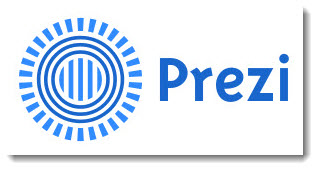
Prezi is not a device, but because it can be used on all devices listed, here is basic overview of font use by Prezi.
- Prezi uses preset fonts from its own font library. All of the Prezi fonts are mapped to common Microsoft fonts (for example, Prezi’s Arimo font, maps to Arial)
- If the desktop version of Prezi is used, custom fonts can be used, but only on desktop Prezi and it can be tricky to have Prezi recognize the custom, non-Prezi, True-Type fonts.
- Prezi uses .Keg (Prezi’s own font format) and TrueType (.TTF) Fonts.
- A nice option is the ability to install the full Prezi font library on your computer if desired. Here is a tutorial on the process: https://prezibase.com/how-to-use-custom-fonts-in-prezi-tutorial/
PowerPoint Web App
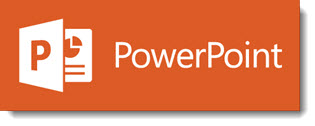
- The online version of PowerPoint can be used on all devices in a web browser. PowerPoint online is basically the same story as Windows 10 Mobile – it has a list of preset fonts and no additional fonts can be added to the list. But Microsoft has expanded list with additional fonts as this variation of PowerPoint has matured.
-Troy @ TLC
Can I Use Google Fonts?
PowerPoint and Google Fonts:
- Professional fonts that display great in presentation apps (PowerPoint, Keynote, Adobe apps, etc.).
- The ENTIRE library is FREE!
- Primarily for web use and designed to dynamically load when a website or web-connected app uses them (so they do not need to be installed on a device to be used. Unfortunately both PowerPoint and Keynote are not able to leverage the web-based dynamic use of Google Fonts).
- Can be downloaded as actual font files, installed on any computer, and both PowerPoint and Keynote can use them.
- A few considerations about using locally installed Google Fonts in PowerPoint and Keynote:
- get previous post details.
Details about Google Fonts
- Google describes their font collection as “hundreds of free, open-source fonts optimized for the web.”
- They have 708 font “families” (a Family is one typeface with several styles).
- Find them here.
- The online Google Fonts viewer has some great features, that can be used on any device. All fonts are displayed with a sample sentence that you can change to be any test. There are also options to see fonts used in a sample paragraph, a single word or very large in poster size text (good example for presentation callouts).
- The ENTIRE library can be downloaded!
- Use the down arrow icon in upper right of webpage to download Google Fonts to your computer.
- Optionally, fonts.com has the SkyFonts app which works with Google Fonts and works similar to the Adobe Typekit. It will sync selected fonts to any computer that has the SkyFonts app installed. Go to it here.
- Download the library at GitHub here.
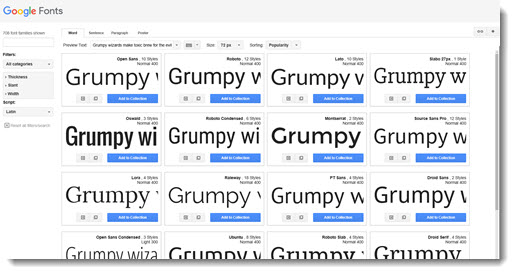
So, should Google Fonts be a part of your workflow?
Adding Google Fonts to your presentations is a good option, assuming you are prepared for managing Custom Fonts in a presentation and assuring everyone has knowledge of how to install custom fonts on a computer, has web access to get the font to install, and is prepared for things not displaying as designed if not installed. The other consideration is, do you need another font option? With our internal library of thousands of custom fonts, and the addition of Adobe Typekit providing its thousands of fonts to our design options, too many options can be more to manage and may provide more design options that are not really needed. But, Google Fonts is a great resource every presentation designer has available if needed.
-Troy @ TLC
Using Adobe Typekit Fonts
Adobe Typekit is a combination between an online tool that previews fonts and an installer that adds them to a computer. Adobe TypeKit is included with Adobe Creative Cloud subscriptions.
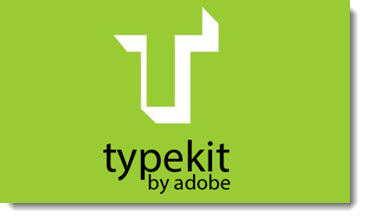
Can Presentation Apps Use Adobe Typekit Fonts?
Yes, if we are talking about desktop PowerPoint and Keynote. Once the Adobe Typekit font is selected and synced to the computer, the font is available in other applications. At TLC, we use PowerPoint for Windows and Mac and Apple Keynote – we can confirm Typekit fonts are available for all of them. Note: PowerPoint may need to be restarted for the font to become available in the font menu.
| Adobe Typekit | Windows | Mac |
| PowerPoint | YES | YES |
| Keynote | N/A | YES |
HOW TO FIND AND INSTALL ADOBE TYPEKIT FONTS
Adobe Typekit is a hybrid app that is web-based, and can also be viewed through the Adobe Creative Cloud app and most Adobe applications (PhotoShop, Illustrator, InDesign, etc.). For our example, we are looking at Typekit through a web browser, which has the most options. Select the font to use in your presentation by going through the font library, select by clicking +USE FONTS (there are a lot of ways to view and search for fonts, and there are thousands of fonts).
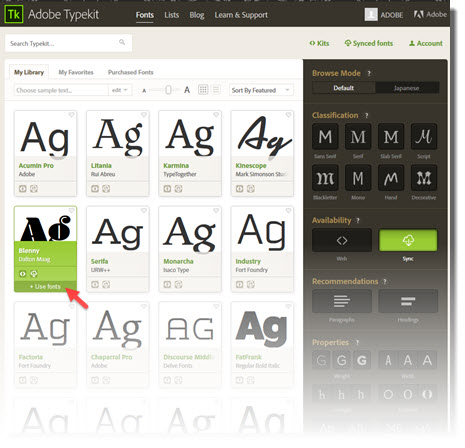
This is where things get a bit confusing. There are two options for using the font: (1) Web Sync, which will make the font available for web use (ie. a website), or (2) Creative Cloud Sync, which will make the font available for use in Desktop apps on a computer. We are installing fonts to a computer for use in PowerPoint.

After selecting fonts and use, click SYNC SELECTED FONTS and they will be installed on the computer.
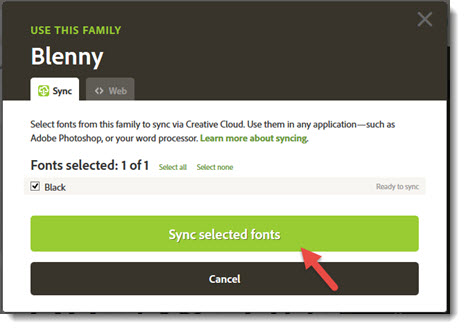
The Creative Cloud Desktop application will open and prompt you to add fonts from Typekit. Below that is a list of all Adobe Typekit fonts currently available.
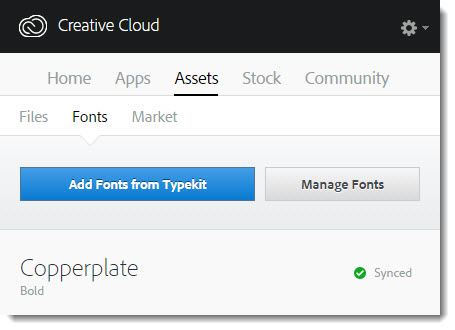
PowerPoint and Adobe Typekit
All Adobe Typekit fonts can be used by PowerPoint on both Windows and Mac, but there are some considerations:
- PowerPoint needs to be started AFTER fonts are installed, or the new fonts will note show up in the font list.
- Typekit fonts are considered “custom fonts” and will need to be installed on any computer that is going to show the presentation.
- Only a computer that has Adobe Creative Cloud installed and has an active user account logged in to an Adobe CC account is going to be able to sync and install Typekit fonts.
- PowerPoint will not warn you that fonts are missing, nor will it tell you where the fonts are from (So an end user needs to look at the font list for missing fonts and know they are Typekit fonts that they can install. TIP: Add a hidden slide or off-slide note about custom fonts and where to find them to help other users).
- Typekit fonts installed on a computer are not actual files that can be accessed and copied to other computers.

Keynote and Adobe Typekit
All Adobe Typekit fonts can be used by Keynote, but there are some considerations: Keynote dynamically recognizes newly installed fonts, so there’s no need to restart it after fonts are installed (great!).
- Adobe Typekit fonts are considered “custom fonts” and will need to be installed on any computer that is going to show the presentation.
- Only a computer that has Adobe Creative Cloud installed and has an active user account logged in to an Adobe CC account is going to be able to sync and install Adobe Typekit fonts.
- Adobe Typekit fonts installed on a computer are not actual files that can be accessed and copied to other computers.

-Troy @ TLC
New Podcast Released today! Episode 5
Troy, Nolan and Sandy talk about fonts and presentation design in the latest Presentation Podcast “Oh, Font.” Episode 5 at The Presentation Podcast!
Fonts You Can and Can’t Use in PowerPoint
With the millions of designs available, fonts have the ability to make text display anywhere from serious to fun.
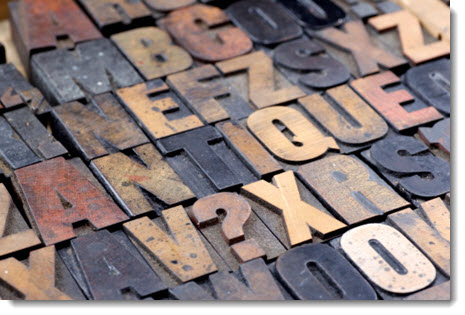
Fonts are separate files that must be installed on each device the custom font is needed. There are Microsoft Fonts, Adobe Creative Cloud Typekit, Google Web Fonts, custom fonts from Font Foundries and websites everywhere – but what is a presentation to use? When selecting fonts, you are selecting physical files.
For example, in PowerPoint, all fonts shown in the font drop down menu are actually individual files installed on that computer (TIP: If there is not an “O” or “TT” icon next to a font, it is not installed on that computer and is not going to display as designed). So first, let’s overview the common types of fonts that can installed.
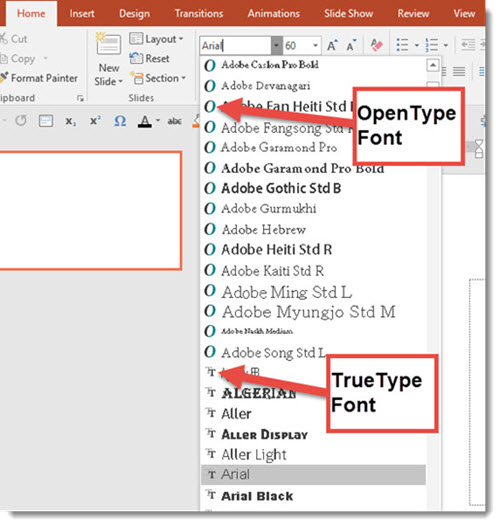
OpenType
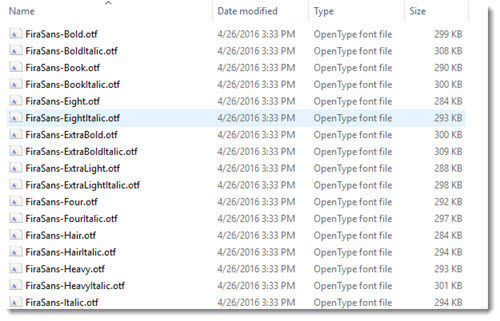
In the history of digital fonts, OpenType is the newest format, with applications adopting its use around the 2,000’s. The extension for OpenType fonts is .OTF and in PowerPoint’s drop down font list, OTF fonts are identified by a large “O” icon. One advantage of OpenType fonts over others is the font file format provides more typographic design options which means more symbols/glyphs/language support/display options. The greater display options (OpenType does not have one display method, but the ability to use legacy display standards and new display standards) mean it is the font file format of choice for newer devices and OS’s – think mobile everything.
Fun Fact: OpenType is a registered trademark of Microsoft, and was developed because Microsoft was unable to license Mac’s “GX Typography” system. Microsoft and Adobe partnered to develop OpenType. Get the full history of OpenType development at this wiki page.
TrueType
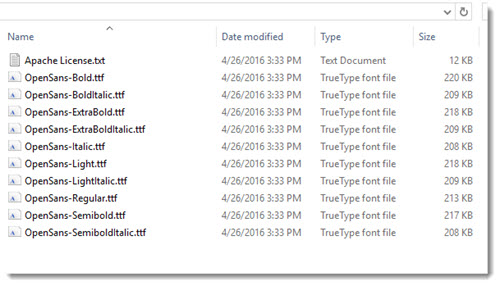
TrueType is still the most common font file type. The extension for TrueType is .TTF and in the PowerPoint font drop down, TrueType fonts are identified with a “TT” icon. True Type is older (than OpenType), a bit less robust when it comes to designing and displaying fonts, but it is the dominant font format used – partially because it is less expensive to license.
Fun Fact: Apple was the first to use TrueType in its 1991 OS with 4 fonts (Times Roman, Helvetica, Courier, Pi), which is originally licensed to Microsoft for free. Full history of TrueType development at this Wiki page.
PostScript
The last font file format for this discussion is our oldest digital font format, which is the most complex. PostScript fonts are actually 2 files. One is for the onscreen display and the other is used for printing where it literally outlines every letter and symbol sent to the printer. The extension is .PS, and PowerPoint does not support PostScript fonts – so we do not see them in the font drop down menu, even if they are installed on the computer. What makes PostScript fonts important for today’s presentations is PostScript fonts were the first font technology to use mathematical computation to dynamically redraw fonts with vector Bezier curve to allow fonts to be any size. PostScript fonts were also the first to contain multiple character sets (ie. multiple languages).
Fun Fact 1: I remember working with PostScript fonts as the only solution for high quality graphic design and typographic work – and spending huge amounts to buy a custom font for projects.
Fun Fact 2: Printers used to be “PostScript-Ready,” meaning the printer actually had PostScript processing built into it.
Fun Fact 3: Adobe developed Type 1 and Type 3 fonts, which are PostScript file types, back in 1984! There was an earlier Type 0 before those, and development with Type 3-4-5-up to 42 (which was introduced in 2010). Full history of PostScript development at this Wiki page.
-Troy @ TLC
What is the Template Color Scheme Name?
Every template has a Custom Color Scheme. And every color scheme has a custom name. For example: Here is a custom PowerPoint template I am working on, and I named the template color scheme “The Future Is Now” which is the theme name of the event where it will be used.
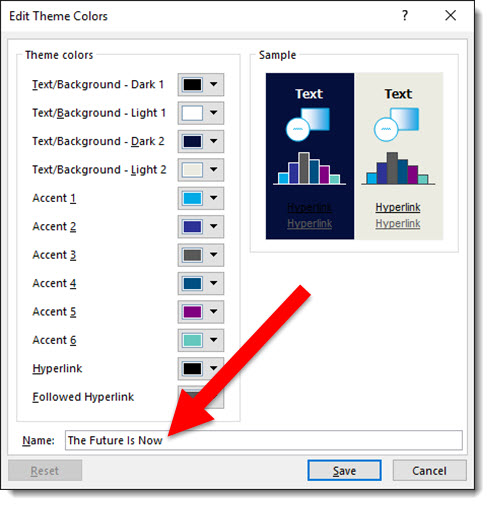
And when I look at the color schemes available on my computer, this theme is listed – because it was created on this computer:
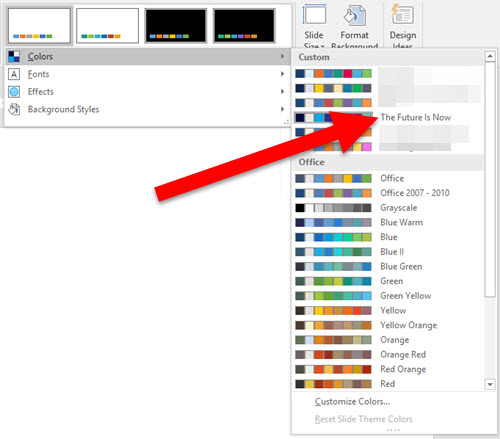
But on any other computer, with the template open, if I look at the color schemes, The Future Is Now is not listed:
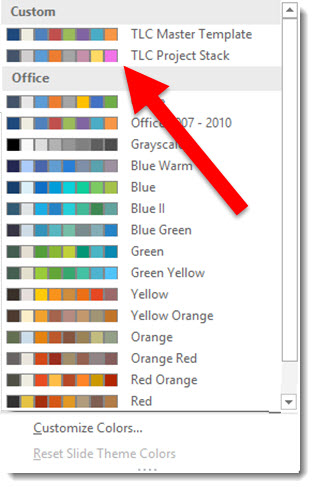
To find the Custom Color Scheme name, do this:
- Go to VIEW > SLIDE MASTER > BACKGROUND > mouse over (do not click) COLORS

- The pop up dialog shows the current template color scheme name
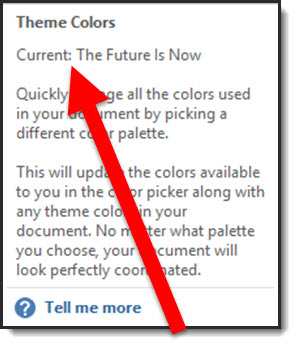
Now you can edit the existing color scheme and know what name to give it.
-Troy @ TLC
Snap to Grid and Nudge
Why do shapes sometimes jump further than you want when moving them with the arrow key? What is the PowerPoint Grid? How are they connected?
Let’s start with the PowerPoint Grid. Using a PowerPoint Grid can be a great tool for slide layout and design. To turn it on/off go to VIEW > SHOW > GRIDLINES check box. Once it’s checked, you’ll see a dotted line grid like this:
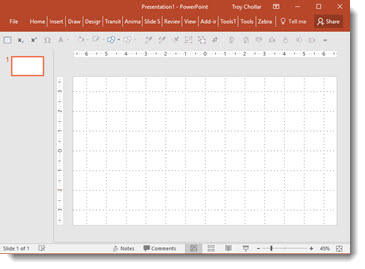
There are some options, such as the grid spacing, and another way to turn on/off. Open the GRID AND GUIDES dialog by going to VIEW > SHOW > click the Options box:
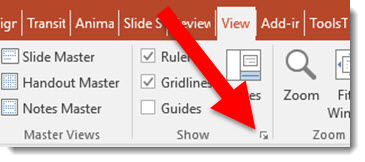
The GRID AND GUIDES dialog has several options for guides, snapping, and grids:
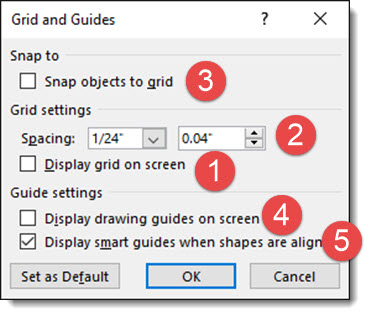
1- DISPLAY GRID ON SCREEN is the same as the above VIEW > SHOW > GRIDLINES. Both turn on/off the gridlines.
2- The spacing, or size of the grid, can be changed here. (Note: The grid spacing is used for the document, so you cannot have a different PowerPoint Grid mixed into a single presentation file.)
3- SNAP OBJECTS TO GRID is what enables objects (shapes, photos, lines, etc.) to “jump” to a location when you are moving them. They are “jumping” to the next gridline. (Note 1: The grid does not need to be visible/on for this to be active. Note 2: I personally do not like objects jumping to locations, so Snap to Grid is turned off on my design computer.)
4- DISPLAY DRAWING GUIDES ON SCREEN can also be accessed a few ways, including as a button on my custom QAT (Note: I use guides in my design process much more than grids).
5- DISPLAY SMART GUIDES WHEN SHAPES ARE ALIGNED is a love-it or hate-it feature (I am in between and turn this on/off as the design needs). It is like SNAP TO GRID, but instead objects snap into alignment with other objects.
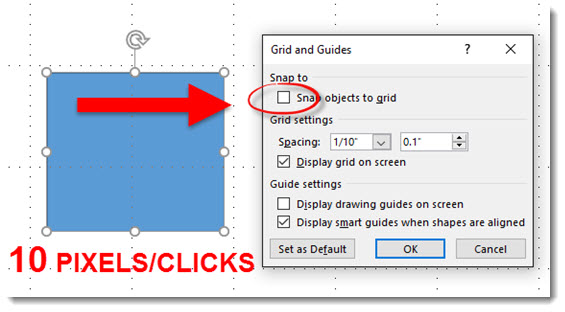
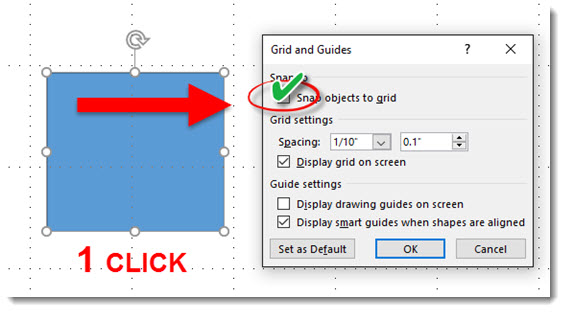

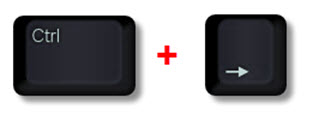
Summary (thanks MS Blair for sending out this simplified grid! [which I modified]):

-Troy @ TLC


